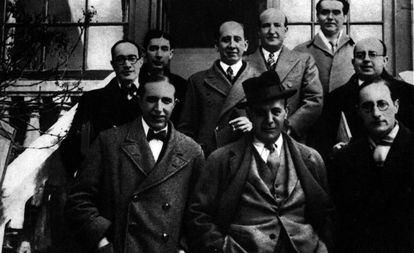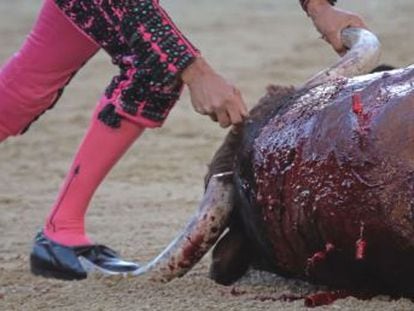Sánchez Mejías, the intellectual bullfighter, returns to the arena
A museum paying tribute to the matador and writer opens in town where he was gored to death in 1934


The story goes that when actress Margarita Xirgu told Federico García Lorca that his friend Ignacio Sánchez Mejías had just announced his return to the ring, the poet went white and muttered, “Ignacio, you have just foretold your own death.”
Earlier, the bullfighter-cum-writer had summed up his decision thus: “I am returning to the bullring because with the passage of the years, the moment of reckoning has come … as I fear danger more than anyone else, I am returning to the arena.”
Soon this unorthodox admission will be on show in the new Museum-Archive Ignacio Sánchez Mejías, scheduled to open in mid-January in the town of Manzanares, in Ciudad Real province.

There is nothing arbitrary about the location of this shrine to the memory of the Seville-born matador, who inspired one of Lorca’s most famous elegies, Lament for the Death of Ignacio Sánchez Mejías. For it was here that Granadino, a docile but treacherous bull, gored Sánchez Mejías’s thigh as he tried to outsmart it from the ‘stirrups’ – the footholds set into the wall of the ring – as he so often did. Doctors who were rushed into the arena wanted to amputate, but Sánchez Mejías refused. He demanded to be taken to Madrid instead. He died from gangrene two days later, at the age of 43.
The museum contains letters, photos, posters, press cuttings, book covers, recordings and Sánchez Mejías’s personal belongings. With an investment of €80,000, Manzanares Town Hall has worked with the bullfighter’s relatives to build this tribute to literature and to bullfighting, with an initial period of 10 years set by his family for the allocation of his personal effects. The initiative has also been supported by the bullfighting association Peña Taurina Ignacio Sánchez Mejías de Manzanares.
Obsessed with literature
Housed in the Casa Malpica building in Manzanares, the exhibition is also a study center for research and literature. Paloma Recasens, Ignacio Sánchez Mejías’s granddaughter, describes the bullfighter as “a very cultured, self-taught man, obsessed with reading the classics.”
History, however, never did justice to Sánchez Mejías, a man of many convictions and contradictions who was at once a matador, a playwright, a novelist, an essayist, a car and plane pilot, a horse rider, the president of the Betis soccer team, a model and, above all, a friend to the influential group of poets known as the Generation of 1927 who came together to experiment with avant-garde forms of art and poetry.
Above politics
Paloma Recasens says that one of the highlights of the Sánchez Mejías Archive is the manuscripts and letters exchanged between her grandfather and members of the Generation of 27, such as Federico García Lorca, Rafael Alberti, Dámaso Alonso… “He was very friendly with Alberti but also with General Sanjurjo; he was above the political moment of that period,” she says, referring to Sanjurjo’s central role in the military uprising that led to the Spanish Civil War.
The conservation of the collection and archive and the organization of cultural activities are to be managed by members of the family as well as the city of Manzanares and the bullfighting association Peña Sánchez Mejías.
He was one of the driving forces behind the famous three-day celebration of the 300th anniversary of the death of Baroque-era poet Luis de Góngora, attended by García Lorca, Rafael Alberti, Luis Cernuda, Vicente Aleixandre, Dámaso Alonso and Gerardo Diego at the Ateneo of Seville on December 17, 1927.
The museum honors the memory of these writers and also the memory of bullfighting legends such as Joselito El Gallo, Juan Belmonte and Domingo Ortega. “We believe that once the archive and museum have been inaugurated, it will grow bit by bit, and become a living thing… several days ago some people got in touch with us to say that they had Sánchez Mejías’s pigtail from the day of his death,” says the Mayor of Manzanares, Julián Nieva.
Also on display is Sánchez Mejías’s Libreto de Sinrazón, a play set in a mental asylum that premiered at the Calderón Theater in Madrid in 1928; the intellectual bullfighter was particularly drawn to the world of the mentally ill, whom he visited regularly in the Miraflores asylum close to his Seville estate, Pino Montano. Next to the Libreto de Sinrazón is a first edition of his novel La Amargura del Triunfo – The bitterness of triumph – which was his only attempt at this literary form. Meanwhile, cuttings and photos show the death of Joselito El Gallo, who was his brother-in-law and the person who introduced him to the world of professional bullfighting.
With the clocks of Casa Malpica in Manzanares stopped at five, as described in Federico Lorca’s famous lament, and bells tolling mournfully in the background, the visitor can peruse the comments written by the journalists of the era specializing in la corrida. Francisco de Cossío, for example, described Sánchez Mejías as having “an absolute disregard for risk”. Néstor Luján paid tribute to his “suicidal displays” in the ring while Gregorio Corrochano wrote: “Ignacio wasn’t the new Pope… he was the guardian of the Vatican.”
Melchor Díaz Pinés’ photos show the actual goring in his right thigh that would prove fatal. A sad end for a legend who was not even meant to be in the ring that afternoon –he was merely standing in for Domingo Ortega, who had been in a traffic accident. Called in as a replacement, he traveled the difficult 550km from Huesca. He was billed to join Alfredo Corrochano, Armillita, and Portuguese bullfighter Simao da Veiga in the Manzanares program.
The museum also showcases a poignant detail of the matador’s final hour – a telephone left off the hook. This is the actual phone from the matador’s house in Madrid, just as his family left it when they rushed out of the house for the hospital. At five in the afternoon. Or as his friend Lorca put it:
“At five in the afternoon.
It was precisely five in the afternoon.
A boy brought in the white sheet
at five in the afternoon.
Everything else was death, and death alone
At five in the afternoon."
English version by Heather Galloway.












































